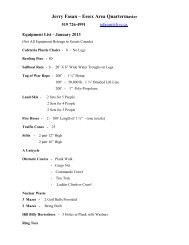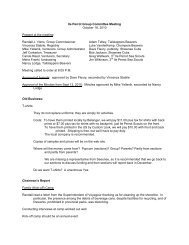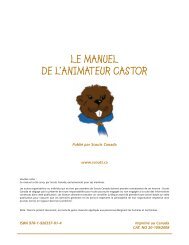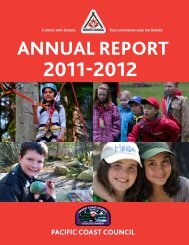Beaver Leader's Handbook - Scouts Canada
Beaver Leader's Handbook - Scouts Canada
Beaver Leader's Handbook - Scouts Canada
Create successful ePaper yourself
Turn your PDF publications into a flip-book with our unique Google optimized e-Paper software.
GOALS AND ABILITIES<br />
Activities, such as crafts, music, storytelling and playacting, provide many opportunities to encourage<br />
<strong>Beaver</strong>s to:<br />
4 Experience and express love and joy<br />
4 Express themselves<br />
4 Develop a sense of belonging, and have good feelings about themselves.<br />
When choosing program ideas, look for things which reflect these program goals and keep in<br />
mind the developmental stages of the five to seven-year-old age group. Within this age range,<br />
senses are developing rapidly and unevenly. Hearing, for example, is not yet fully developed.<br />
Between five and seven, the ability to coordinate wrist and finger actions develops; older <strong>Beaver</strong>s<br />
have a more precise grip than younger ones.<br />
You will notice quite a range of ability between your younger and older <strong>Beaver</strong>s. That’s why many<br />
leaders organize craft activities by tail groupings. In this way, they can challenge each age group<br />
slightly differently, to hold their interest and ensure everyone some degree of success.<br />
Remember, everyone learns differently when learning a new game or skill (think of learning to<br />
tie your shoes). Some people learn by listening, some by watching and doing, or by reading<br />
illustrations. Try to incorporate different styles of presenting an idea or skill with variety and<br />
ways to appeal to your whole colony.<br />
Leaders often notice that, although <strong>Beaver</strong>-aged children change activities less often than<br />
younger children, they still have a lot of energy to burn. Younger <strong>Beaver</strong>s, especially, are good at<br />
starting crafts but may lose interest before completing them. With <strong>Beaver</strong>s, it’s very important to<br />
remember that trying and experiencing a craft is more important than the outcome.<br />
Busy <strong>Beaver</strong>s (White Tails) tend to settle down and use less energy than their younger friends.<br />
They’re more able to concentrate for longer periods of time but, when they’re tired, even these<br />
children tend to behave like younger <strong>Beaver</strong>s.<br />
Imagination begins to blossom throughout the age range, and one of the primary jobs of <strong>Beaver</strong><br />
leaders is to nurture this wonderful element. Puppetry, skits, drama and stories are marvelous<br />
ways to tap and stimulate these growing minds.<br />
CRAFTS<br />
It’s important to use crafts to encourage self-expression rather than imitation. As much as possible,<br />
let older <strong>Beaver</strong>s plan and develop a product from an idea. Brown Tails may prefer to construct<br />
their own version of a model you have shown them.<br />
4 Collect items all year. Have a leader store the supplies.<br />
4 Visit local craft stores for ideas and some supplies. (They often give discounts to groups.)<br />
4 Read over <strong>Scouts</strong> <strong>Canada</strong>’s resource books, and check out the Leader Magazine.<br />
4 Visit libraries and search the internet for craft ideas.<br />
14-1








